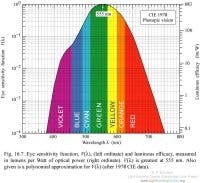RadiometryRadiometry and radiometric units such as radiant flux relate to properties associated with the energy of electromagnetic radiation (which for LEDs we'll refer to as "light" - this term covers visible light, as well as UV and IR radiation).
Photometry
Photometry and photometric units such as luminous flux relate to the properties of light with reference to the sensitivity of the human eye (i.e. when the eye is the sensor).
RADIOMETRIC PROPERTIES
Radiant flux
The radiant flux or radiant power of a light-emitting body is the total rate of flow of emitted light i.e. the total radiant energy per unit time.
* Units: watts (W)
Radiant intensity
The radiant flux per unit solid angle - in other words, the optical power in a given direction.
* Units: watts/steradian (W/sr)
Radiant efficiency
The ratio of the radiant flux (photons produced = Watts out) to the amount of power consumed (electrons used = Watts in) i.e. how efficiently the source converts electrical power into light. Also known as wall-plug efficiency.
Radiant efficiency (wall-plug efficiency) = optical power / electrical power
* Units: none (ratio)
PHOTOMETRIC PROPERTIES
As stated above, photometric properties takes account of the sensitivity of the human eye to different wavelengths of light.
Luminous flux
Luminous flux measures the total radiant flux across the spectrum, weighted by the sensitivity of the human eye to different wavelengths i.e. weighted by the V(λ) curve.
* Units: lumen (lm)
The lumen is an SI unit derived from the candela (see below): lumen = candela.steradian.
Luminous intensity
For a point source, luminous intensity is the luminous flux per unit solid angle (i.e. flux in a particular direction)
* Units: lumens/steradian (lm/sr), equivalent to candela (cd)
The candela is an SI unit defined as the luminous intensity in a given direction of a source that emits monochromatic radiation of frequency 540 x 1012 Hz (equivalent to a wavelength of 555 nm) and that has a radiant intensity in that direction of (1/683) watt per steradian.
Luminance
Luminance is the luminous intensity per unit emitting area for a non-point source. To the observer, the property of luminance corresponds to the brightness of the source.
* Units: candela/square meter (cd/m2), equivalent to nit
Note that for any source it is not possible to increase either the flux or the luminance.
Luminous efficacy
Luminous efficacy measures how effectively the eye converts radiant flux into a visual sensation.
Luminous efficacy of a source (often called simply “luminous efficacy” or “source efficacy”) is the ratio of output luminous flux (lm) to input electrical power (W).
Luminous efficacy of radiation is the ratio of luminous flux (lm) to radiant power (W), and is therefore the theoretical maximum that a light source with a given spectral distribution can achieve with 100% radiant efficiency.
Based on the definition of a lumen, the theoretical maximum value of luminous efficacy is 683 lumens/watt for a monochromatic 555 nm source that converts all electrons to photons.
* Units: lumens/watt (lm/W)
Illuminance
Illuminance is the density of the luminous flux incident on a surface. Its value is determined by luminous intensity, angle of incidence and distance from the source to the surface.
* Units: lumen/square meter (lm/m2), equivalent to lux.
* Alternative unit: foot-candle, equivalent to lumen/foot2. To convert from foot-candle to lux, multiply by 10.764.






